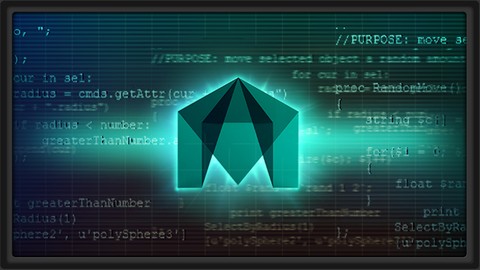
An Introduction to Scripting in Maya
An Introduction to Scripting in Maya, available at $44.99, has an average rating of 4.05, with 14 lectures, based on 56 reviews, and has 408 subscribers.
You will learn about Distinguish the difference between MEL and Python Scripting Utilize the scripting reference Understand MEL and Python Syntax Understand Conditional Statements Comprehend the Pros / Cons of Each Language This course is ideal for individuals who are Those looking to get their feet wet with programming and tool creation inside of Maya. It is particularly useful for Those looking to get their feet wet with programming and tool creation inside of Maya.
Enroll now: An Introduction to Scripting in Maya
Summary
Title: An Introduction to Scripting in Maya
Price: $44.99
Average Rating: 4.05
Number of Lectures: 14
Number of Published Lectures: 14
Number of Curriculum Items: 14
Number of Published Curriculum Objects: 14
Original Price: $19.99
Quality Status: approved
Status: Live
What You Will Learn
- Distinguish the difference between MEL and Python Scripting
- Utilize the scripting reference
- Understand MEL and Python Syntax
- Understand Conditional Statements
- Comprehend the Pros / Cons of Each Language
Who Should Attend
- Those looking to get their feet wet with programming and tool creation inside of Maya.
Target Audiences
- Those looking to get their feet wet with programming and tool creation inside of Maya.
In this course, instructor Chad Morgan will go through the basics in writing scripts in Maya in both MEL and Python. We will begin by discussing the difference between MEL and Python, why there are two different languages, and the pros and cons to each. We will show you how to bring up the scripting reference which will allow you to search the commands and their parameters so you can learn to create your own scripts. We demonstrate the syntax on both MEL and Python commands in Maya, including passing arguments to them.
We will demonstrate how to create procedures and definitions, what variables are and how to create them, and how to pass variables between procedures and definitions. Following that, we will show, in both MEL and in Python, some of the more common functions in programming. The first are iterators, which allow us to perform the same task over lists of objects and comes in several forms. The second function common to all programming languages is the conditional statement, which allows us to test conditions before executing code and allowing us to branch the program depending on what conditions are met. We finish by demonstrating how to save and reload your scripts in both languages.
(Students – please look under Section 1 / Lecture 1 downloads for the source files associated with the lesson.)
More about the Instructor:
Chad Robert Morgan started his career at LucasArts where, as a newbie to the industry, was fortunate enough to work with some very talented mentors who taught him how to use Maya. Since then, Chad has been trying to pay it forward by sharing what he has learned, first by giving lectures at Autodesk Master Classes, then publishing an article in 3D World magazine, posting tutorials on YouTube, and finally teaming up with 3dmotive. Chad currently lives in Lake Forest, CA with his wife Carol and his son Xander.
Course Curriculum
Chapter 1: Introduction
Lecture 1: Download Course Files Here!
Lecture 2: Introduction
Lecture 3: What is MEL and Python
Lecture 4: Procedures and Definitions
Lecture 5: Variables and Scope
Lecture 6: Arrays and Lists
Lecture 7: Passby Reference
Lecture 8: Understanding Iterators
Lecture 9: Interators Continued
Lecture 10: Understanding Conditional Statements
Lecture 11: Refining Conditional Statements
Lecture 12: Saving and Sourcing
Lecture 13: Conclusion
Lecture 14: Bonus Lecture: Further Learning with 3dmotive
Instructors
-
3dmotive LLC
High Quality 3d and Game Art Training by Industry Pros!
Rating Distribution
- 1 stars: 3 votes
- 2 stars: 2 votes
- 3 stars: 14 votes
- 4 stars: 20 votes
- 5 stars: 17 votes
Frequently Asked Questions
How long do I have access to the course materials?
You can view and review the lecture materials indefinitely, like an on-demand channel.
Can I take my courses with me wherever I go?
Definitely! If you have an internet connection, courses on Udemy are available on any device at any time. If you don’t have an internet connection, some instructors also let their students download course lectures. That’s up to the instructor though, so make sure you get on their good side!
You may also like
- Top 10 Content Creation Courses to Learn in December 2024
- Top 10 Game Development Courses to Learn in December 2024
- Top 10 Software Testing Courses to Learn in December 2024
- Top 10 Big Data Courses to Learn in December 2024
- Top 10 Internet Of Things Courses to Learn in December 2024
- Top 10 Quantum Computing Courses to Learn in December 2024
- Top 10 Cloud Computing Courses to Learn in December 2024
- Top 10 3d Modeling Courses to Learn in December 2024
- Top 10 Mobile App Development Courses to Learn in December 2024
- Top 10 Graphic Design Courses to Learn in December 2024
- Top 10 Videography Courses to Learn in December 2024
- Top 10 Photography Courses to Learn in December 2024
- Top 10 Language Learning Courses to Learn in December 2024
- Top 10 Product Management Courses to Learn in December 2024
- Top 10 Investing Courses to Learn in December 2024
- Top 10 Personal Finance Courses to Learn in December 2024
- Top 10 Health And Wellness Courses to Learn in December 2024
- Top 10 Chatgpt And Ai Tools Courses to Learn in December 2024
- Top 10 Virtual Reality Courses to Learn in December 2024
- Top 10 Augmented Reality Courses to Learn in December 2024






















